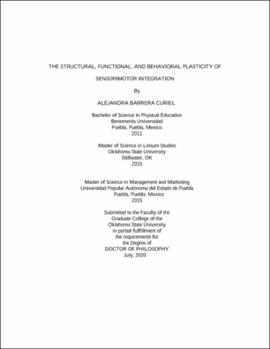| dc.description.abstract | The general purpose of this dissertation was to analyze structural, functional, and behavioral changes of sensorimotor integration. Study 1 was designed to analyze the effects of altered stretch reflex sensitivity, via vibration, on motor unit behavior. We discovered that altering muscle spindle function resulted in altered MU behavior, with an increase in recruitment thresholds, decrease in firing rates, and reduced motor output; 9% reduction in maximal strength. Study 2's goal was to analyze structural and functional changes associated with aging, their relationships, and how they affect performance. Older adults had smaller CSARF (~5cm2), lower MQRF (~14 au), greater RMAG (~10% MVC), less STR (~101Nm), slower RTD (~554 Nm/s), and poorer balance (~ 0.5 sway index) when compared to the younger. The middle-age group had smaller CSARF (~2 cm2), less STR (~ 39 Nm), slower RTD (~ 415 Nm/s), and poorer performance (~0.29 sway index) when compared to the young group. When comparing the middle-age group to the older group, the older group had smaller CSARF (~3cm2), less STR (~63 Nm) and poorer balance performance in the balance conditions EOSS and ECSS (~0.55 sway index). Variance in STR and RTD were explained by CSARF and RMAG (STR: ~65%; RTD: ~13%). However, most of the variance in RTD was explained by MQRF (~32%). Regarding balance, RMAG was the functional variable explaining most of the variance in EOSS (~30%) condition and CSARF explained most of the variance in ECSS (~99%). Study 3 was designed to identify the determinants behind the age-related changes in antagonist muscle coactivation. The study is still in progress; so far it seems that the variables related to greater coactivation are: cortical agonist-antagonist representation areas overlap, the location of the muscles center of gravity and cortical inhibition. Therefore, age alters many dimensions in the control of voluntary movement; in these studies, we showed the relationship between spindle function and motor unit behavior and output; then we saw discovered significant relationships between sensory variables and motor variables and how they affect performance. In conclusion, to understand the aging process, it is important to analyze plasticity of sensorimotor integration as a whole. | |
